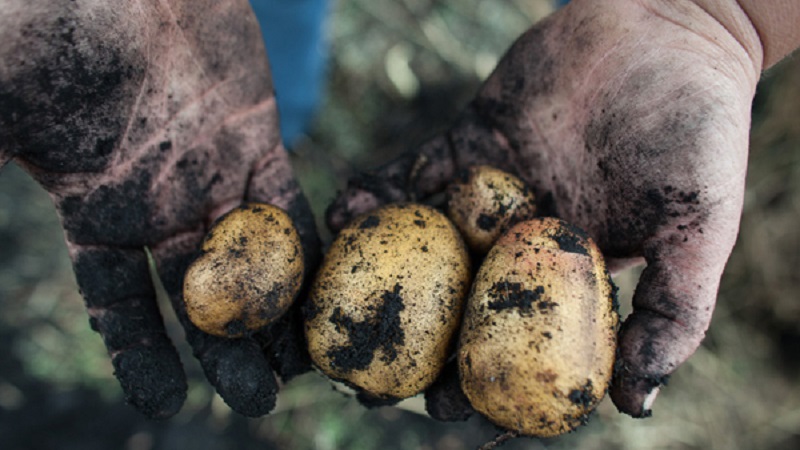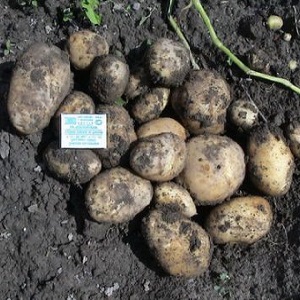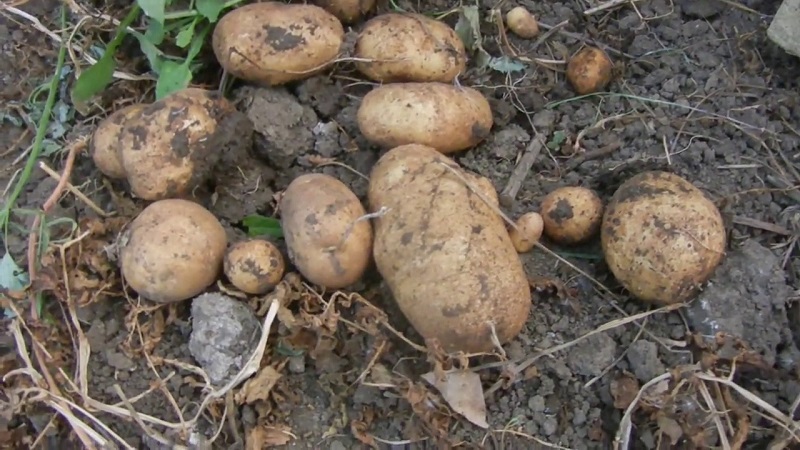Popular variety of high-yield potatoes "Repanka"
Repanka is a mid-season potato with yellow flesh and rough skin, suitable for growing in warm regions. It is cultivated in summer cottages and farms. The variety is absent from the state register, but farmers and gardeners appreciate it for its high yield and taste of tubers.
The content of the article
Description of the variety
Repanka refers to table varieties of potatoes... For most gardeners, yield and early ripening are in the first place. The repank combines both qualities.
Origin and development
There is no Repanka variety in the register. This is the name given to potatoes by gardeners and farmers because of the external similarity to turnips - it has bright yellow flesh. According to another version, the potato got this name because of the flaky peel.
Experts believe that the name unites several varieties with similar properties.... Potatoes are gaining popularity, planting material is being distributed among professional farmers and amateur gardeners.

Chemical composition, trace elements and vitamins
Starch content is 10-15%.
In 100 g of raw potatoes, about 87 kcal. Repanka is rich in vitamins and valuable trace elements:
- carotene;
- B vitamins;
- vitamin E;
- phosphorus;
- potassium;
- iron;
- silicon.
Ripening period
The first shoots appear 70-75 days after the planting material was laid into the ground. The collection of young tubers is possible 45-50 days after germination.
Yield
In general, the yield depends on the weather conditions, the soil almost does not play a role. The average figure is 400 c / ha. 10-15 potatoes are obtained from the bush... There are practically no small and deformed tubers.
Disease resistance
Repanka characterized by increased resistance to disease... It is rarely affected by potato crayfish, scab, golden nematode.
To prevent infections, the soil must be thoroughly treated before planting. disinfectants, for example, a drug "Prestige"... It is necessary to loosen and remove the remnants of last year's plants.
Repanku often attacked by cicadas, colorado beetles, wireworms, spider mite... The best prevention is to change the landing site every few years.
Repanka receptive to late blight... This infection often affects nightshade crops. If action is not taken right away, a significant portion of the crop will suffer.
Description of potato varieties Repanka
 Repanka tubers have an oval, slightly flattened shape... The peel color varies from light pink to pink-red, the color is uniform. The eyes are poorly expressed, the tubers are even and smooth, without tubercles.
Repanka tubers have an oval, slightly flattened shape... The peel color varies from light pink to pink-red, the color is uniform. The eyes are poorly expressed, the tubers are even and smooth, without tubercles.
Yellow or creamy pulp, sometimes there is a pronounced blush. The average weight of red rough potatoes of this variety is 100-130 g.
Bushes are low, with lush dark green foliage... In hot weather, it protects from the sun and retains moisture in the soil. The flowers are large, set quickly, but also fall off. The berries on the bushes are not tied.
Growing regions and climate requirements
Repanka suitable for cultivation in central Russia, as well as in the southern regions... The variety is not picky about care and is resistant to diseases. Potatoes tolerate drought well, they are not afraid of light frosts. With a minimum of care, a decent harvest is guaranteed.
Repanka successfully grown in Russia, Ukraine, Belarus... Farmers from Central Asia, where the drought lasts most of the summer, also try to cultivate it.
Advantages and disadvantages of the variety
Repanka is not demanding to care for, because of this, many summer residents and farmers choose it. The variety is also appreciated for its excellent taste. Potatoes do not boil and do not crumble, they are suitable for any dishes.
Advantages:
- potatoes cook quickly, taste good;
- high productivity;
- resistance to most diseases;
- early ripening - young tubers can be dug in the first half of summer;
- drought resistance;
- tubers are able to withstand short-term spring frosts without loss of yield.
The disadvantage is the dependence of yield on the weather... Unfavorable weather conditions affect the appearance of the tubers - a lot of ugly potatoes appear. For summer residents, this is not critical, and it is difficult for a farmer to realize such a crop.
Difference from other varieties
Repanka, although it belongs to early varieties, but the safety of the crop is 90%. Other types of early ripening potatoes cannot boast of this.
Features of planting and growing
This the variety is not cultivated on an industrial scale... The cultivation is carried out by small farmers and gardeners. Planting and further care of the Repanka is not particularly different from similar procedures with other varieties.
Preparing for landing
Medium potatoes are selected for planting... It is not recommended to take tubers of an ugly shape, damaged, or with rot. You can have a small one - it's hard to sell it. Such tubers do not degenerate, they produce a good harvest.
Council. Don't cut the potatoes. Such savings in planting material reduces the quality of the crop.
Designed for landing tubers in early spring are treated with a growth stimulant... After drying, lay out in the light so that they begin germinate.
Ground requirements
Repanka feels good in almost any soil.... And even better - in the fertile black soil. If potatoes are grown in heavy loamy soils, there is a high chance of blackleg infestation. The yield also depends on the preparation of the soil.
Attention! Before planting, you need to remove the remnants of last year's plants and treat the soil with a disinfectant.
To prevent infection of bushes and in order to increase yields, it is not recommended to plant potatoes in the same place. Ideally, if the selected area has previously grown carrots, cabbage, legumes or radishes.
Timing, scheme and landing rules
Start disembarkation tubers in the ground possible from the second half of April, based on the climatic features of the region... If spring is early and warm, an April planting would be ideal. If spring frosts often occur in the region, it is better to postpone planting until early May. In arid areas, on the other hand, you should not delay planting.
Reference. After planting, the temperature should not drop below + 10 ... + 12 ° С. If the soil is too cold, the tubers will freeze and start to rot.
The optimal distance between the bushes is 30-35 cm. Before laying the planting material, it is recommended to put wood ash or humus in the holes.
Growing features
In the cultivation process, standard agricultural technology is used... Additional procedures for harvesting are not required.
Repanka does not require any special care. It is necessary to perform basic tasks: timely weed control, regular watering and feeding.
Watering mode
The variety is drought tolerant.During the season, 2-3 organized waterings are enough - during the flowering and formation of tubers. If the summer is too hot and dry, you can build a drip irrigation system on the site.
Top dressing
For the whole season, two applications of mullein are enough: For 10 liters of water, take 1 liter of fresh manure, stir and wait for fermentation. You can replace it with a chemical fertilizer, for example, ammonium nitrate (for 10 liters of water, 20 g of a substance) or a potassium-phosphate complex (for 10 liters of water, 25 g of a substance). The resulting mixture is distributed between rows.
Attention! The increased nitrogen content in the soil speeds up ripening, but such tubers will not be stored for a long time.
Once a summer it is necessary to spray the bushes with a solution of "Superphosphate" - 100 g of substance per 10 liters of water. This is the final feeding, it is carried out 10 days before harvest.
Weeding and hilling
Weed removal is essential at all stages of the growing season, starting from the emergence of sprouts and ending with the formation of dense tops. After the shadow from it drowns out the weeds, but for prevention, you can periodically tear large grass.
Hilling is carried out at least twice... This beneficial procedure increases air access to the tubers and promotes moisture retention in the soil. The first hilling is done when the shoots reach 15-20 cm. After two weeks, the procedure is repeated.
Disease and pest control
Despite strong immunity against diseases and pests, infection can occur... In this case, it is recommended:
- Dressing tubers to protect against root and apical rot. For 10 liters of water, you will need 1 g of potassium permanganate and 10 g of copper sulfate.
- In the fight against the wireworm and the Colorado potato beetle, drugs "Tabu", "Aktara", "Prestige" help.
- Periodic spraying of bushes with compositions containing copper. This will help avoid late blight. If the stems have already begun to turn black, you can reanimate them with Consento and Revus chemicals.
- If signs of scab, black leg, rot are already found, you need to treat the bushes with Maxim.
Growing difficulties
As such, there are no difficulties with Repanka... But she is loved by the Colorado potato beetle. You need to think in advance how to fight the pest - poison with chemicals or collect by hand.
Often late blight affects the culture. It is necessary to immediately remove diseased plants from the beds, and process the remaining ones. Otherwise, the disease will take up to half of the crop.

Harvesting and storage
Harvesting Is the most enjoyable part of the job. But in order to keep potatoes as long as possible, you need to prepare and take into account some of the nuances.
How and when to collect
You need to start harvesting in late August or early September, do not delay longer. You should take into account the nature of the weather in the region at this time. If it rains, there is a risk of losing a significant part of the crop.
A week before the expected digging, the tops are cut... The tubers will have time to grow up and accumulate useful trace elements.
Dug potatoes are dried directly in the beds or laid out under a canopy... After a week, the tubers are ready to bookmark for storage.
Storage features and keeping quality of the variety
Store harvested potatoes in bags or boxes. A cellar, an insulated barn or a glazed balcony are suitable as storage... Before being sent to the prepared container, the potatoes are sorted out. Damaged tubers are laid, it is desirable to use them faster.
Important! Future planting material is stored separately from potatoes for food.
Tips from experienced gardeners and reviews about the Repanka variety
Tips from experienced farmers:
- For planting, it is better to choose the southern section of the garden. It is good if from the north it is protected by trees or shrubs.
- Do not bury the tubers deeply, otherwise the crop will be shallow.
- Organic fertilizers have a bad effect on taste, so it is better to use chemicals.
- It is recommended to plant catnip, tansy, nasturtium along the edges of the beds to scare off the Colorado potato beetle.
Gardeners love Repanka for taste and unpretentiousness to weather conditions and soil type... It is recommended to be grown by amateurs - even in the absence of experience in cultivating potatoes, a generous collection is guaranteed.
Ruslan, Lodeinoe Pole: “Very good potato variety. Large and fleshy fruits, pleasant flesh color, as in the photo on the Internet. Stored for a long time, not afraid of frost. In breeding does not require special care ".
Anatoly, Orsk: “Winter-hardy variety. The tubers are large, the weight of one is 120 g on average. It has good taste. ".
Lyudmila, Pskov: “The fruits are not watery, with a rich taste. Due to the moderate starch content, the potatoes do not boil over, retain their shape. Any dish can be prepared from it ".
Conclusion
Repanka is a universal mid-season variety. It is not demanding on the type of soil, irrigation, fertilization. Differs in productivity and high taste. The Repanka variety is suitable for those who are interested in a generous harvest, but cannot devote much time to caring for the plantings.